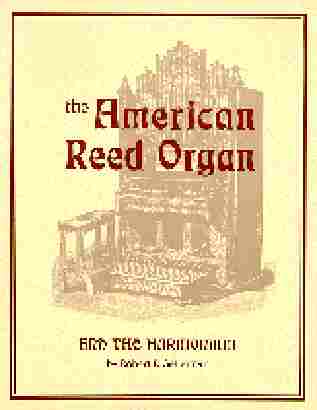
Chapters:
The American Reed Organ and the harmonium
A Treatise on its History, Restoration and Tuning.
Outstanding Collections, including a Stop Directory
and a Directory of Reed Organs.

Chapters:
Introduction
History of the Reed Organ
The Selling of the Reed Organ
Stops and Voices
Music for the Reed Organ
Portable Organs
The Instrument Which Plays By Itself
Restoration
Tuning
Collecting and Collections
A Reed Organ Gallery
Appendix:
Stop Faces
Tuning Devices
Bench Plans
pages: 303
photographs (black & white) and illustrations: 437
cover: available in either cloth or paper
published in 1996
Publisher:
The Vestal Press, Ltd.
Vestal, New York 13850
Order Through:
Madison Books, Inc.
4720 Boston Way
Lanham, MD 20706
telephone: 301-459-3366
Review by Henry Doktorski:
Vestal Press published the original edition of The American Reed Organ more than twenty years ago. In the early 1970s reed organs were little more than almost-forgotten curiosities. A handful of pioneers had put together collections enjoyed by themselves and all too few visitors. A few professional restorers were laboring away in near anonymity. Small numbers of new reed organs were still being built in Germany, Japan, China and India. Printed material on the reed organ was scarce at that time.Then in 1981 a small group of aficionados began discussing the formation of an organization devoted to the reed organ. Early the next year The Reed Organ Society was founded, and began publishing The Reed Organ Society Bulletin. During the next decade, interest in the reed organ began to spread and membership grew to 600 members in fourteen countries.
Robert Gellerman's new revised edition of The American Reed Organ is a monument to a beautiful free-reed instrument which reached its peak of popularity in the 1890s. His book is scholarly, written with painstaking care to detail. It is also massive, consisting of 303 pages and 437 photographs and illustrations. The book is a veritable encyclopedia on the reed organ in America.
The chapter titled Stops and Voices has a section titled The Free Reed Sound which is the most complete explanation I have ever seen of the reason the free-reeds make sound the way they do, even going to the extent of including a graph of a spectrum analyzer showing the strength of the various overtones.
There are eight copies of short musical scores of pieces for harmonium and a listing of twenty-seven recordings of reed organs and harmoniums. In the chapter titled Portable Organs Gellerman tells the story about how the US army purchased 1,200 folding organs for army chaplains to use for religious services during World War II.
Gellerman's book is also filled with humorous stories and even twenty-seven hilarious Gasoline Alley comic strips which tell the story of a harmonium. The following advertisement is from a Rochester New York reed organ manufacturer, ca. 1880:
I recommend this book for all lovers of the free-reed instruments.
| About The Free-Reed Review |
| Invitation to Contributors / Submission Guidelines |
| Back to The Free-Reed Review Contents
Page |
| Back
to The Classical Free-Reed, Inc. Home Page |